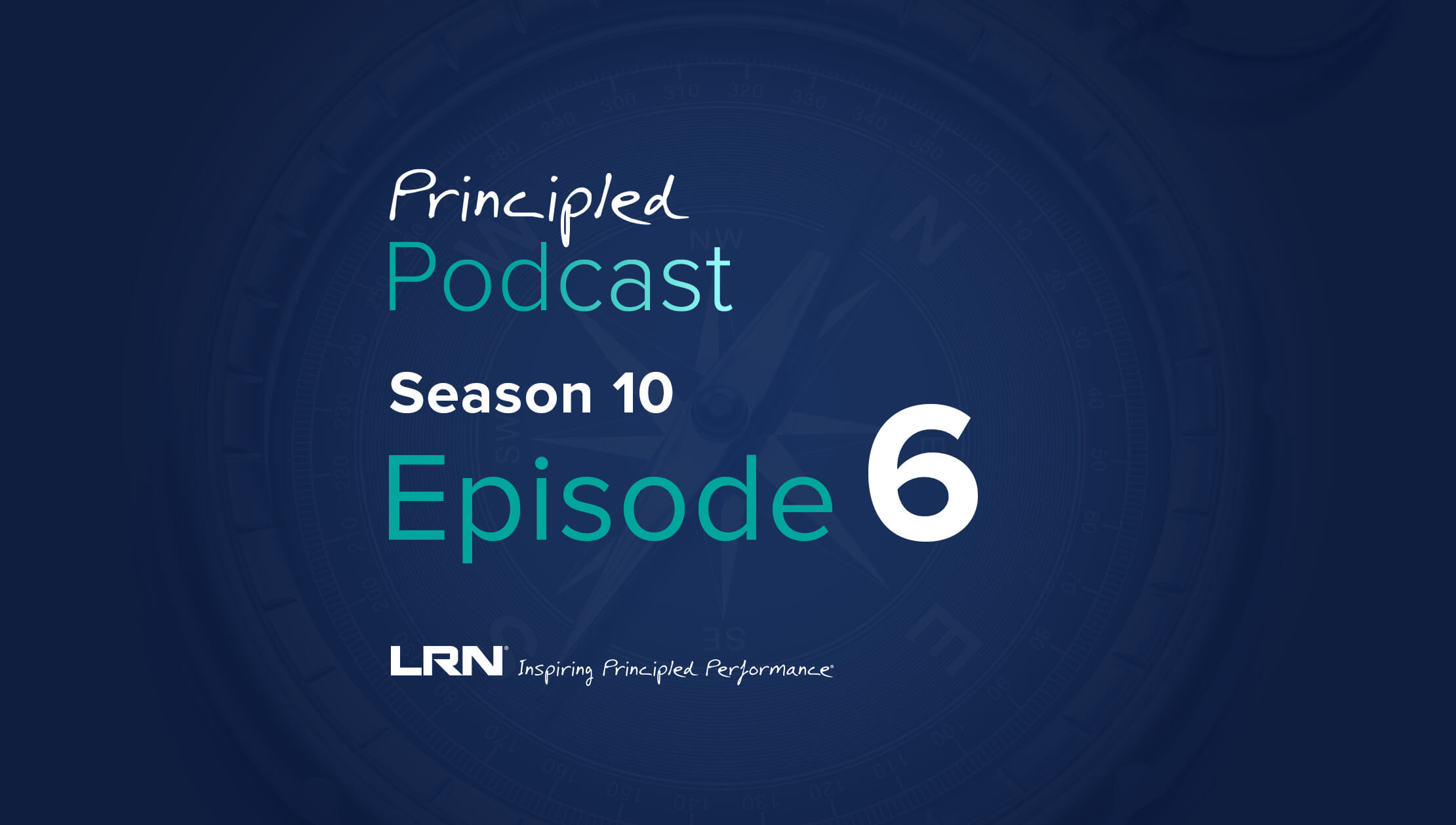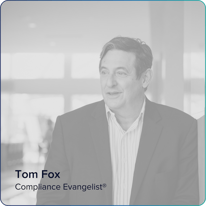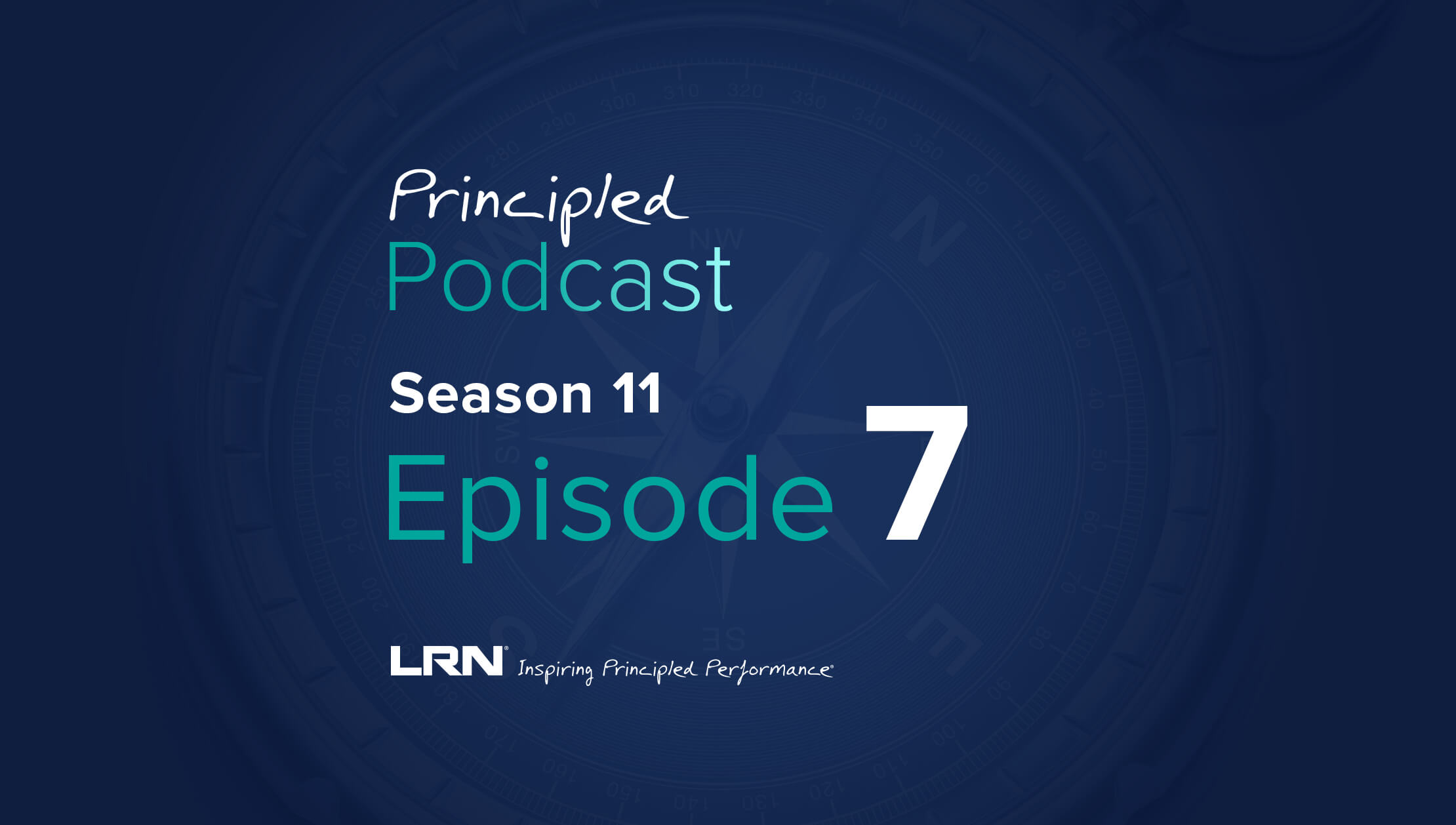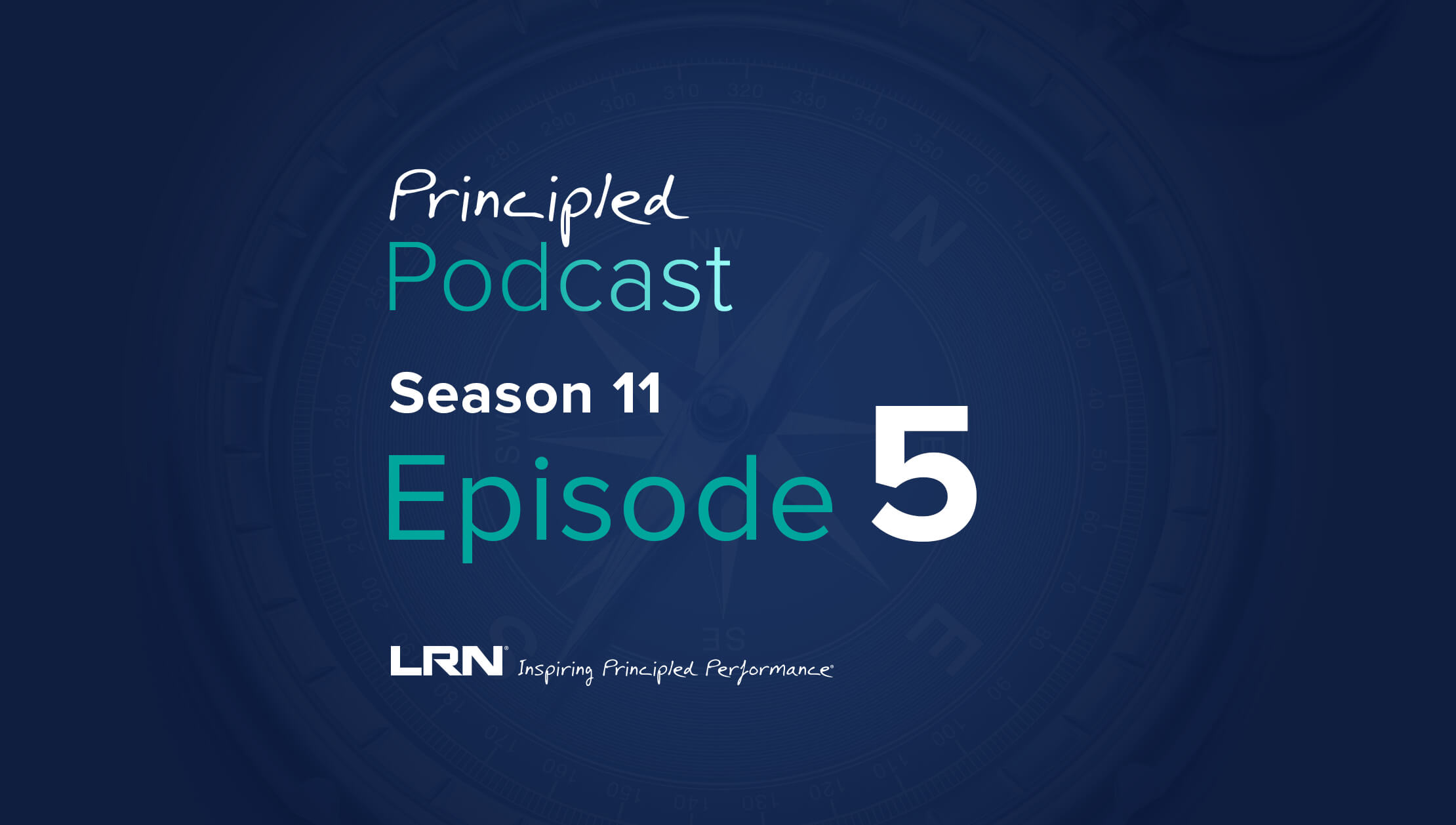What you'll learn on this podcast episode
A company code of conduct should reflect the character, culture, and values of an organization, serving as a foundation for its ethical culture. The best codes are designed as useful resources for employees, providing guidance on ethical decision-making and access to detailed information and resources. But how can organizations ensure their codes are structured effectively to meet these needs? In an episode of the FCPA Compliance Report, host Tom Fox dives into the topic of code effectiveness with Jim Walton, director of Advisory Services at LRN and leader of LRN’s code of conduct practice. Listen in as the two unpack the latest findings and best practices from LRN’s 2023 Code of Conduct Report.
Listen and subscribe to the FCPA Compliance Report through the Compliance Podcast Network or wherever you get your podcasts.
Where to stream
Be sure to subscribe to the Principled Podcast wherever you get your podcasts.
Guest: Jim Walton
Jim Walton is a member of LRN’s Ethics & Compliance Advisory Services team with over 25 years of professional experience in corporate, institutional, and government settings—spanning the fields of ethics and compliance; environment, health, and safety; and energy management.
Since 2002, Jim has been passionately dedicated to corporate ethics and compliance – designing, developing, implementing and enhancing constantly-evolving, comprehensive, best-in-class, global ethics and compliance programs. Jim has extensive experience in writing, producing and communicating codes of conduct and corporate policies; designing, managing and implementing ethics and compliance risk assessments; implementing anti-compliance and bribery initiatives; conducting third-party due diligence reviews; and helping managers at all levels become better ethical leaders.
Jim is a Certified Compliance and Ethics Professional.
Host: Tom Fox
Tom Fox is literally the guy who wrote the book on compliance with the international compliance best-seller The Compliance Handbook, 3rd edition, which was released by LexisNexis in May 2022. Tom has authored 23 other books on business leadership, compliance and ethics, and corporate governance, including the international best-sellers Lessons Learned on Compliance and Ethics and Best Practices Under the FCPA and Bribery Act, as well as his award-winning series "Fox on Compliance."
Tom leads the social media discussion on compliance with his award-winning blog, and is the Voice of Compliance, having founded the award-winning Compliance Podcast Network and hosting or producing multiple award-winning podcasts. He is an executive leader at the C-Suite Network, the world’s most trusted network of C-Suite leaders. He can be reached at tfox@tfoxlaw.com.
Principled Podcast transcription
Intro: Welcome to the Principled Podcast, brought to you by LRN. The Principled Podcast brings together the collective wisdom on ethics, business and compliance, transformative stories of leadership, and inspiring workplace culture. Listen in to discover valuable strategies from our community of business leaders and workplace change makers.
Carolyn Grace: Hey there, listeners. This is Carolyn Grace speaking, the producer of LRN's Principled podcast. This week we're excited to share a recent episode from the FCPA Compliance Report podcast hosted by Tom Fox, the founder of the Compliance Podcast Network. Tom talks to LRN's own Jim Walton about key findings from our 2023 code of conduct report, which is available now at lrn.com. It's a great discussion and I hope you enjoy it.
Tom Fox: Hello everyone. This is Tom Fox back for another episode, and we are all in for a treat today because I have Jim Walton with me. Jim, first of all, welcome and thank you so much for coming on today's podcast.
Jim Walton: Thanks for having me, Tom. I really appreciate it.
Tom Fox: Jim, could you tell us a little bit about your educational and professional backgrounds?
Jim Walton: Certainly, I'd love to. So I graduated from Rutgers University with an engineering degree a long time ago, and believe it or not, I started out in solar energy, and in 1988 I was hired by AT&T to run their global energy management program, which we actually received recognition from the Clinton White House on our climate change mitigation efforts. So from there I moved into environment health and safety. And then in 2002, after Enron and WorldCom, my company that I worked for at the time realized they needed a separate department and program dedicated to ethics and compliance. So I joined that group to help build and nurture the program. I'm happy to say that I've been dedicated to ethics and compliance ever since.
Tom Fox: Jim, what's your current role?
Jim Walton: So I'm currently a director on LRN's advisory services team, and I joined LRN back in 2016. And since that time, I've been leading our code of conduct practice, so helping our clients update their codes of conduct, reinvent them, help them make them more effective and better at meeting the requirements that they have for their audiences.
Tom Fox: Given your current role, I think our listeners will understand then why we're going to talk about the LRN Code of Conduct report. So if I could start with what is the report?
Jim Walton: Yeah, so the report is something that we publish where we evaluate codes of conduct of different companies. We've created a proprietary code assessment methodology, which is something that we use when a company engages us to help them with their code of conduct. And in that methodology we look at eight dimensions of a code effectiveness. And so we've established what we consider leading practices within each of those eight dimensions. So we decided to create a report where we would share some of our findings with the ethics and compliance community, giving people a sense of how are companies doing with their code of conduct, what are they doing well, where are there room for improvement, and what are some of the examples that they might be able to look at to help them move forward with their codes.
Tom Fox: Jim, from a big picture view, what were some of the key findings that you saw?
Jim Walton: Yeah, there was some good news. What we did is we looked at the largest companies on several of the indices throughout the world. We looked at the CAC in France, the DAX in Germany, the FTSE in the UK, the S&P in the US, and then in 2023 we added the Nikkei in Japan and the SGX in Singapore. And the good news is that if you look at a combined percentage for codes, evaluated, fell into the more effective or more effective category. So overall companies are doing a good job. They understand the need for a code of conduct, they understand the basic standards and expectations around codes. The bad news is that only 17% fell into what we would consider the more effective category, which means that they've really started to adopt the best practices and leading practices. So this suggests that there's significant room for improvement across even some of the largest companies in the world.
Tom Fox: Jim, did you notice any difference between or across geographies that LRN looked at?
Jim Walton: Sure. So not surprisingly, the codes of companies with primary listings in the US Exchange really scored the highest, but not by a lot. So they were followed closely by the UK, Germany, and France, but we saw that there was quite a drop off with the Japanese companies and the Singapore companies. And we can postulate that. There's been such an emphasis in the US and Europe on compliance programs and really professionalizing them and making them quite comprehensive. And with all of the regulatory bodies that are looking at codes in those areas, I think that makes sense that those areas would be doing better. But we really are looking at, the things that we're looking at are universal and they would apply to a company no matter where they're located in the world.
Tom Fox: Jim, I certainly think and perhaps hope that everyone listening to this podcast understands the reason to have a code of conduct, but many compliance professionals actually don't understand the interaction of how a code can impact an overall compliance program. So I was wondering if you could maybe say a few words about that.
Jim Walton: Certainly. And a code really has a lot. A code has a lot to do, a lot on its point to do. We like to think about a code of conduct as an organization's character and culture written down. So it really articulates for an organization who they are, what they believe, why they're in business in the first place. It provides insight into not only what they value, but how those values are actually lived out every day by everyone associated with the organization. But even more than that, an effective code of conduct inspires employees by connecting them to the organization's higher purpose, by connecting them to the values and then guiding them in how to live those values out very specifically in very specific behavioral terms. And then finally enabling them to become ethical decision makers and risk spotters, because it's really the employees that are on the front lines and they're going to see things that the ethics and compliance group or the legal department doesn't really see or understand how that impacts them personally on their job. So it's really literally the foundation of a company's ethical culture.
And then we also want it to be a useful resource that employees will turn to time and again, whenever they have a question about anything related to ethics and compliance, they should be able to pull up the code on any device that they're using, quickly find the information they're looking for, the high level guidance, the principles, but then be able to click on links where they can find more detailed information, policies, training, videos, whatever they need, and even resources of people that can help them answer any questions that they have.
Tom Fox: Jim, one of the report is just packed with information. And it's packed with information in a way that I think every compliance professional can use as a benchmark, but equally or if not more importantly, to use going forward. And one of the ways you start to do that is what I've called the elements of an effective code of conduct, but you called them the dimensions and they're just a great way to think about this. So I was wondering if we could literally just go through each dimensions and you say a few words about them.
Jim Walton: So we created these dimensions, probably even predating me going back to about 2015. And one of the things that we do is over time as things change, as we learn more, as technology changes, the industry changes. We are constantly updating them, but the main categories still remain the same. Right from the start, the tone from the top it's really important for a leader to give a message. We're encouraging people more and more to put video messages, embed those in the code because it's always great to hear from the leader living and breathing. And we also encourage people to use pictures that are more casual and more inviting because we want people to feel like that leader really gets who they are and understands why it's important for them to pay attention to the code.
The next one is the purpose and values orientation. And what this one is about is really elevating a code of conduct to a higher level. In the past, codes of conduct were defensive documents, legal documents, things that the company could point to and say, we trained Jim, he signed the code of conduct, he still did bad things, so it's Jim's fault. And now what we want to do is really make it, you have your purpose, which is why everyone gets up in the morning to go to work and why they stay working for your organization, the values which are the guideposts towards achieving that purpose, and then the code of conduct, which really explains in detail what the behaviors are that help us live out those values. The next one, applicability administration. It's the nuts and bolts of who does the code apply to. And we're very surprised at times when we review a code of conduct of a very well-known company, and they don't even tell you who the code applies to.
So it's important to say, Hey, this applies to everyone, employees, executives, officers, board of directors, we expect our suppliers and contractors to meet the same standards that we meet. That's an important one. It's the nuts and bolts of the code and it's important in spelling that out. Speaking up, we talk about that all the time, how important that is to encourage people. So it's really about explaining to them the importance of speaking up. Also letting them know that if they do speak up, there will be no retaliation, giving them lots of different options also, because some people may not automatically want to call the hotline or submit a report on a website that there's individuals and people that they can talk to about that. The risk topics, it's about making sure that it's a comprehensive coverage of the risk topics, the high and medium risks that apply to most people in the organization. So you want to make sure you're covering, you've got comprehensive coverage, but also for each of those risk topics to talk about what it is, what is the principle, why it's important, why does it matter, why should I care?
And then the behavioral guidance, which is really the how of that particular topic. Knowledge reinforcement is another real key, and that's one where we found actually the lowest scores across the board in our code report were knowledge reinforcement, and we think that it's important to include things like a policy, links to policies, links to training, so people can call up the training program that's associated with that particular risk topic, Q7A scenarios, bringing it to life as well as links to other resources that can help people understand that topic if they need more information. And then finally, the usability and look and feel. Those two are very much related, but it's how the code is laid out, how it's designed. Is it easy on the eyes? Is it easy for people to find information through the code? Is it digital? And we've seen a lot of progress with digital PDFs, but now the trend is really moving towards web-based codes, and those are making even more usable and easy for people to jump around and find the information that they need.
Tom Fox: Jim, if a new customer or client came to you and LRN, and we have a code, but we need a serious revamp and we don't know where to start, could they use something like the dimensions or would you counsel them to maybe look in a different direction?
Jim Walton: Yeah, so that's a good question. That's one of the reasons why we wanted to make the code report available and give people some insight into those dimensions. But we could also, if we're working with a client or a company, we could say, Hey, let's run an assessment on your code and we'll put it through our evaluation and we'll give you some specifics about what you're doing well, which you want to build on for the next phase, and then what are those areas for improvement? And it gets very specific in each of those areas, and sometimes the companies will go off on their own and do it themselves, but other times they'll ask us to help them with the production, the writing, the design, the delivery. We can work with people where they are, we try to meet them where they are.
Tom Fox: Jim, how do you strike the balance between needing to say some things that may tend towards being more legalistic like anti-competitor or antitrust issues, harassment issues, anti-corruption issues, as opposed to as you articulated in the second dimension, purpose and values orientation, where you really want people to understand that this is a values-based company and here are our values and here's how we want you to literally live those as an employee. How do you strike that balance between the legalistic and the values?
Jim Walton: Yeah, it really is a balance. One of the things that we try to do, and a lot of times it's an education project working with a company, helping everyone, especially the policy owners and the subject matter experts, understand that they don't have to put every requirement in the code, especially if you can link out to policies and procedures and other resources that can get into a lot of those legal specifics and really trying to keep the code at a very high level. And so we employ a team of, usually have an ethics and compliance advisor like myself and others on my team working with professional writers that can help us put the wording into plain language that people can understand. And we do quite a bit of measuring of readability, so we have another tool that we run all of our drafts through so people can see the grade level, the readability, the tone, the sentiment, all these different metrics, and it really helps them see that, wow, it really makes sense to make this more understandable for people and looking for ways to say the same thing using fewer words.
And so we measure that. We measure the word count of each draft. And so it's also a balance in terms of what some clients are ready for. We'll work with some clients who feel like, Hey, you know what? I can cover a risk topic in one bullet point. We tend to think you should probably use a full page to cover a risk topic. It's hard to do it in one bullet point, but the days of having codes that just go on and on and list every single possible legal requirement, those should be long gone.
Tom Fox: Jim, you mentioned the term policy owner. I wanted to ask you, who owns the code? Is it the board of directors? Is it compliance? Is it senior management? Is it a combination or perhaps something else?
Jim Walton: I think it really is a combination. The document we've really, like I've mentioned earlier, we want to elevate it up to the level that it's really a business enablement document, so we want everyone to feel a sense of ownership for it, and typically it has to go up to the executive level for approval and the board has to approve it. But usually the ethics and compliance department is the one who owns the document itself and is the facilitator of getting the document through the various review cycles and getting it through the approval process. That's also part of the education process where we want everyone to feel like they're part of it. One of the things we always ask is make sure you've got all your stakeholders involved in the early phases of the code, make sure you've got human resources and legal and the business and regional representation. We want to make sure that the code really reflects everybody and everything that the company does.
Tom Fox: Jim, you mentioned the use of the code as a defensive document and some years back it perhaps was seen more in that vein, but when I was in the corporate world, it was actually a powerful tool for employees both internally and to external stakeholders or even customers or other companies I was negotiating with across the table to be able to say, I'm sorry, we can't do that. That would be a code of conduct violation. We can't do that, or it has to go to the board of directors for approval. I'm not doing that. Is that something that people can still and do use the code of conduct for?
Jim Walton: Oh, absolutely, yes, and that's why we really try to focus on getting those kinds of principle statements into the code of conduct. So when we're talking about respect that we foster respect in everything that we do, we believe in human rights of people. We don't conduct business using any form of bribery and corruption, these kinds of statements that can really sink in with people and they're easy for people to understand, and if they're asked to do something that feels like they're being asked to violate the code by having these kinds of principles helps everyone understand what it is that they should be doing.
Tom Fox: Jim, unfortunately, we are near the end of our time for this episode, but before we leave, I wanted to ask you if our listeners wanted to actually get a copy of this code of conduct or find out more about you, your team, or LRN, what would be the best place or places for them to go?
Jim Walton: Yeah, I'd encourage your listeners to visit lrn.com or follow LRN on LinkedIn, and there you'll be able to find out more not only about the work that we're doing with codes of conduct and some of the other research and reports that we've written, blog posts that we've done, that can be very helpful finding information as well as ways that LRN can help enhance your ethics and compliance program, from advisory services to education to disclosure processes, to data analytics.
Tom Fox: I'm just going to echo that particularly specifically around this document. I obviously had the chance to read it prior to this podcast, and I found it to be a fabulous report chockfull of information that I suggested earlier could be used as both a benchmarking and a good forward. So I wanted to thank you and your team, Jim, for putting this great resource together, and I look forward to continuing this conversation.
Jim Walton: Thank you so much, Tom, and thanks for having me.
Tom Fox: This is Tom Fox. Again, thank you so much for listening to this episode of the FCPA Compliance Report. If you've enjoyed this episode, I hope you'll subscribe, rate and review wherever great podcasts are listened to. I'd like to tell you about two great new podcasts on the Compliance Podcast Network, Adventures and Compliance, where I look at the intersection of Sherlock Holmes, leadership, compliance and business ethics. I'm doing all of the Sherlock Holmes stories as well as the novels. Another is Report from ECI 2023 where I interviewed speakers, guest and participants at ECI 2023. I know you'll enjoy both of these new podcasts.
Carolyn Grace: Thanks again for listening. You can get a copy of LRN's 2023 Code of Conduct report at lrn.com or click the link in our show notes. I'm Carolyn Grace, and we'll see you next week on the Principled Podcast.
Outro: We hope you enjoyed this episode. The Principled Podcast is brought to you by LRN. At LRN, our mission is to inspire principled performance in global organizations by helping them foster winning ethical cultures rooted in sustainable values. Please visit us at lrn.com to learn more. And if you enjoyed this episode, subscribe to our podcast on Apple Podcasts, Stitcher, Google Podcast, or wherever you listen. And don't forget to leave us a review.
Be sure to subscribe to the Principled Podcast wherever you get your podcasts.
















